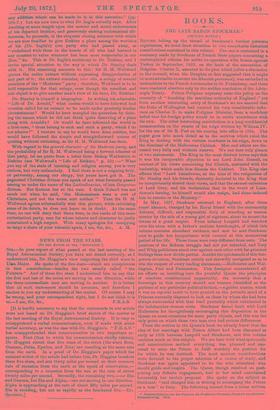NEWS FROM THE STARS.
[TO THE EDITOE OF THE "SPECTATOR.']
SLR,—In your report of what passed at the last meeting of the Royal Astronomical Society, you have not stated correctly, as I understood him, Dr. Huggins's view respecting the chief stars in IJasa Major. He spoke of the five stars—which are conspicuous in that constellation—besides the two usually called "the Pointers." And of these five stars I understood him to say that the first and last of the series are moving in one direction, while the three intermediate ones are moving in another. It is better that all such statements should be accurate, and therefore I enclose to you my understanding of the matter. Of course I may be wrong, and your correspondent right, but I do not think it is [It is hardly necessary to say that the statements in our article were not based on Dr. Huggins's brief sketch of the matter at the last meeting of the Royal Astronomical Society. It is easy to misapprehend a verbal communication, even if made with strict verbal accuracy, as was the case with Dr. Huggins's. " F.R.A.S." has misapprehended that communication in two important re- spects. First (that to which his communication chiefly relates), Dr. Huggins stated that five stars of the seven (the stars Beta, Gamma, Delta, Epsilon, and Zeta) are receding at the same rate from the earth. In a proof of Dr. Huggins's paper which the eminent writer of the article had before him, Dr. Huggins brackets these five stars, and sets thirty miles per second as their common rate of recession from the earth at the epoch of observation,— corresponding to a recession from the sun at the rate of about twenty miles per second. Secondly, the remaining two,—not Eta and Gamma, but Eta and Alpha,—are not moving in one direction. Alpha is approaching at the rate of about fifty miles per second. Eta is receding, but not so rapidly as the bracketed five.—En. Spectator.]


































 Previous page
Previous page